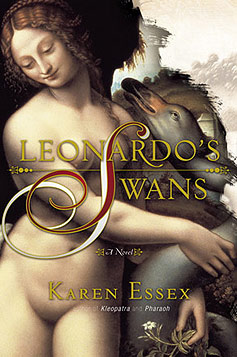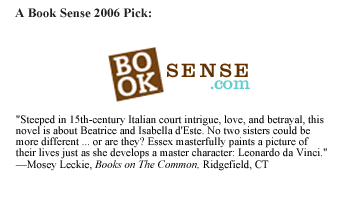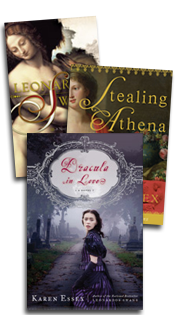
Embraced not only by readers worldwide, but by Italy’s most respected art historians and critics, Leonardo’s Swans recreates the decadence, glamour and treacherous politics that defined the Renaissance. Set against the glittering backdrop of the court of Milan, Essex paints the canvas of a world in which no pleasure was denied to those in power, and where the fate of Europe lay in the balance. Here, where Leonardo was creating his most enduring masterpieces—The Last Supper, The Virgin of the Rocks, the Mona Lisa, The Lady with an Ermine—a great rivalry between two royal sisters began.
At the heart of Leonardo’s Swans is the complex relationship between two of Leonardo’s patrons and muses, Isabella and Beatrice d’Este. Despite their love for each other, a lust for power drove them both. Isabella was known throughout Europe for her unparalleled beauty, poise, intelligence, and exquisite taste. Her tempestuous younger sister, 15-year-old Beatrice, was an equestrienne and lover of the outdoors. Beatrice’s naïve and rebellious nature complemented her childish appearance, but as all would soon discover, these innocent looks hid darker complexities.
While initially thrilled by her marriage to the future Marquis of Mantua, Isabella’s happiness turns to jealousy when Beatrice is married off to the infinitely more powerful Ludovico Sforza—the future Duke of Milan. Though he is her sister’s husband, this playboy and powerbroker fascinates the young Isabella. He also holds the key to her life ambition—to be immortalized in oil by the great Leonardo da Vinci. Underestimating Beatrice’s will for supremacy, Isabella embarks on a plan to seduce Ludovico. As Europe begins to crumble around them, the sisters find themselves in a desperate game, caught between familial loyalty and a perilous battle for power.
Leonardo’s Swans uncovers the history of the illustrious Este sisters, as well as the mystery, genius, and drama behind Leonardo’s most famous works. The painter’s presence drives the story as his art divides the sisters farther apart. Drawing on excerpts from Leonardo’s own notebooks and letters, Essex reveals the human side of the artist, who, despite his now legendary status, was then a man caught between expressing his own genius and appeasing his demanding and powerful patrons.
In her research, Essex traversed northern Italy, visiting Ferrara, where the sisters were born, as well as Milan and Mantua, where Beatrice and Isabella reigned, and the lesser known rural “pleasure palaces” of the royals. Essex poured through the sisters’ personal correspondence as well as hundreds of accounts of court life in the Renaissance. Her evocative and accurate portrait the era prompted Italy’s premier art historian, Vittorio Sgarbi, to lavishly praise the book and already has inspired many teachers to use the book in their classes.
As in her acclaimed biographical novels, Kleopatra and Pharaoh, Essex once again reveals women’s hidden history and delivers an historical novel whose details encompass the social, political and artistic currents of its time and place. What emerges is not only an entertaining escape to Renaissance Italy but a smart, sophisticated, and multi-textured novel.
PRAISE FOR LEONARDO’S SWANS FROM THE AMERICAN AND ITALIAN PRESS




